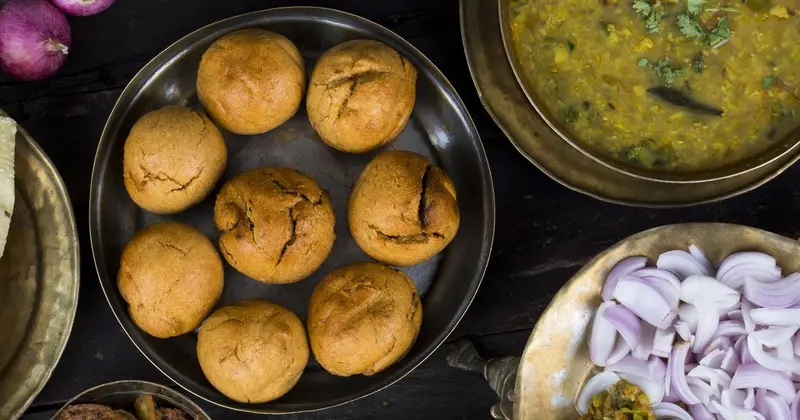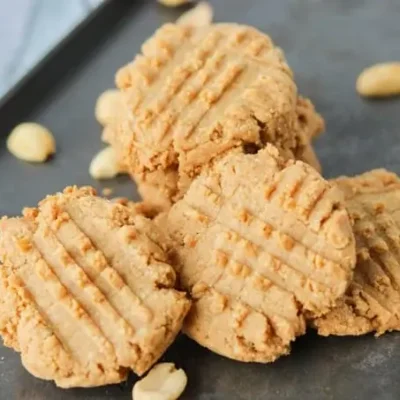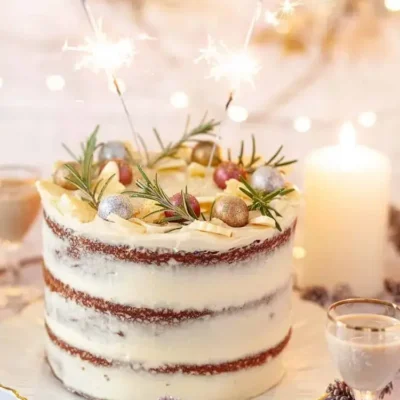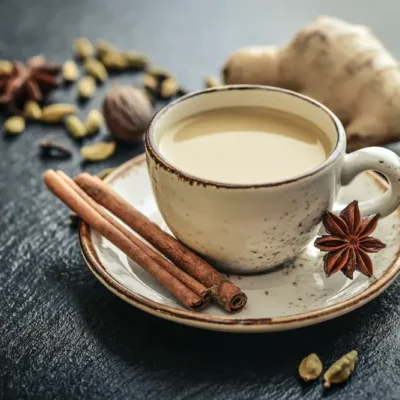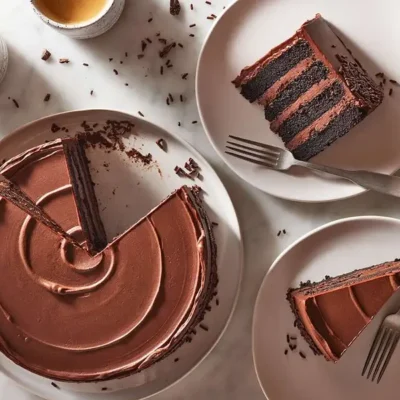Dal Bafla, a cherished gem in the vast tapestry of Indian cuisine, stands as a testament to the rich culinary heritage of the region. Originating from the heartlands of India, particularly Rajasthan and Madhya Pradesh, this dish has transcended its regional boundaries to find a special place on dinner tables across the country.
On a personal note, I fondly recall the first time I tasted Dal Bafla during a trip to Rajasthan. The warm aroma of freshly baked baflas, combined with the rich and creamy texture of the dal, left an indelible mark on my palate. It wasn’t just a meal; it was an experience—a harmonious blend of flavors and traditions that told a story spanning generations.
Historical Background of Dal Bafla
The roots of Dal Bafla trace back to the arid landscapes of Rajasthan and the cultural heartland of Madhya Pradesh. Historically, this dish emerged as a staple for the hardworking locals, offering a hearty and nutritious meal that could sustain them through long, challenging days.
Originally, Bafla (or Bati) was prepared using coarse grains, primarily millets, which were abundant in these regions. These dough balls were then baked in the traditional mud ovens, imparting a unique smoky flavor. On the other hand, the Dal, a rich lentil curry, provided the essential proteins and nutrients, making it a wholesome combination.
Over the years, as culinary traditions mingled and evolved, the Dal Bati recipe witnessed subtle modifications. The introduction of wheat flour made the baflas softer, while adding various spices and ingredients enhanced the dal’s flavor profile. Yet, at its core, the dish remained a symbol of community, tradition, and the rich agrarian culture of India.
Ingredients
For Bafla (Bati):
- Whole Wheat Flour: 2 cups
- Semolina (Sooji): 1/2 cup
- Clarified Butter (Ghee): 1/2 cup
- Yogurt: 1/4 cup
- Baking Powder: 1 teaspoon
- Salt: to taste
- Water: as required for kneading
For Dal (Lentil Curry):
- Toor Dal (Pigeon Pea Lentils): 1 cup
- Water: 3 cups
- Turmeric Powder: 1/2 teaspoon
- Red Chili Powder: 1 teaspoon
- Coriander Powder: 1 tablespoon
- Cumin Seeds: 1 teaspoon
- Mustard Seeds: 1/2 teaspoon
- Asafoetida (Hing): a pinch
- Tomatoes: 2, finely chopped
- Onions: 1, finely chopped
- Green Chilies: 2, slit
- Garlic: 3-4 cloves, minced
- Ginger: 1-inch piece, grated
- Fresh Coriander Leaves: for garnish
- Ghee: 2 tablespoons
Optional Accompaniments:
- Freshly churned butter
- Garlic chutney
- Pickled green chilies
- Onion rings in lemon juice
Preparation Time
Preparing the Bafla dough is a meticulous process that ensures the perfect texture and flavor. On average, it takes about 20-25 minutes to knead the dough thoroughly, incorporating the ghee, yogurt, and other ingredients to achieve the desired consistency.
Once the dough is ready, shaping and preparing the individual bafla balls can take an additional 10-15 minutes, depending on your pace and the quantity being prepared.
When it comes to cooking, the Baflas traditionally require a two-step process: first, they are boiled and then baked or roasted. Boiling them typically takes around 15-20 minutes, ensuring they’re cooked through. After boiling, baking or roasting them until they achieve a golden-brown hue can take another 20-25 minutes.
Simultaneously, the Dal needs to simmer and cook to perfection. Cooking the lentils with the spices and seasonings can take approximately 30-35 minutes, allowing the flavors to meld beautifully.
In total, from the preparation of the dough to the final cooking of both the Baflas and Dal, you’re looking at an estimated time of 1 hour to 1 hour 15 minutes.
Also read: Bihari Litti Chokha Recipe: A Traditional and Healthy Dish
Step-by-Step Cooking Process
5.1. Bafla Preparation
Making the Dough:
- In a large mixing bowl, combine whole wheat flour, semolina, baking powder, and salt.
- Add clarified butter (ghee) to the dry mixture and incorporate it well using your fingers, ensuring the mixture resembles breadcrumbs.
- Gradually add yogurt to the mixture and begin kneading. Slowly add water as needed to form a firm, yet pliable dough. The dough should be smooth and free from cracks.
Shaping and Preparing the Bafla:
- Once the dough is ready, divide it into equal-sized portions and roll them between your palms to form smooth balls.
- Flatten each ball slightly to give it a disc-like shape, ensuring they are of uniform thickness. This ensures even cooking.
- Optional: Make a small indentation in the center of each bafla. This helps in even cooking and ensures the insides are cooked thoroughly.
Different Cooking Methods:
- Baking: Preheat your oven to 375°F (190°C). Place the shaped baflas on a baking tray and bake for 20-25 minutes or until they turn golden brown, flipping them once halfway through.
- Steaming: In a steamer, arrange the baflas on the perforated plate. Steam them for about 15-20 minutes until they are cooked through and have a slightly firm texture.
- Frying: Heat ghee or oil in a deep frying pan. Once hot, reduce the flame to medium and carefully add the shaped baflas. Fry them until they turn golden brown and are crisp on the outside.
No matter the method chosen, ensure the baflas are cooked through and have a golden-brown exterior before serving.
5.2. Dal Preparation
Sorting and Washing Lentils:
- Begin by taking the Toor Dal (Pigeon Pea Lentils) in a large bowl.
- Sort through the lentils to remove any stones, debris, or imperfect grains.
- Rinse the lentils under cold water, gently rubbing them between your fingers. Repeat this process 2-3 times until the water runs clear, ensuring they are clean and free from any impurities.
Preparing the Masala/Tadka:
- In a pan or kadai, heat ghee over medium heat.
- Add cumin seeds and mustard seeds. Allow them to splutter.
- Add a pinch of asafoetida (hing) followed by finely chopped onions.
- Sauté the onions until they turn translucent.
- Introduce minced garlic, grated ginger, and slit green chilies. Sauté for another 2-3 minutes until the raw aroma dissipates.
- Incorporate the chopped tomatoes into the mixture. Cook until they soften and the oil begins to separate from the masala.
- Now, add turmeric powder, red chili powder, and coriander powder. Stir well to combine, ensuring the spices are well-coated with the masala.
Cooking the Lentils to Perfection:
- Transfer the sorted and washed lentils to the prepared masala mixture.
- Stir well, ensuring the lentils are well-coated with the masala.
- Pour in the water, adjusting the quantity based on your desired consistency. Remember, dal tends to thicken as it cooks, so it’s better to keep it slightly runny initially.
- Season with salt according to taste and give it a good mix.
- Bring the mixture to a gentle boil, then reduce the heat to low-medium. Cover and let it simmer for about 30-35 minutes, or until the lentils are soft and well-cooked.
- Occasionally, give the dal a stir to prevent it from sticking to the bottom of the pan.
- Once the dal reaches your desired consistency and the lentils are tender, turn off the heat.
Your Dal is now ready, infused with the rich flavors of the masala and ready to be paired with the freshly prepared Baflas!
You may like: Festive Flavors of India: Learn How to Make Gujiya at Home
Serving Suggestions
How to Serve Dal Bafla Traditionally:
- Begin by placing a couple of freshly baked or steamed Baflas on a plate.
- Using a spoon, gently crush the baflas, ensuring they soak up the dal when served.
- Ladle the piping hot dal over the crushed baflas, ensuring they are generously coated.
- Optionally, garnish with a drizzle of melted ghee for added richness and flavor.
- Serve immediately while still warm for the best taste and texture.
Recommended Side Dishes and Accompaniments:
- Garlic Chutney: A spicy and tangy chutney made from fresh garlic cloves, red chilies, and lemon juice. It adds a kick to the dish.
- Freshly Churned Butter: A dollop of homemade butter can elevate the richness of the dish, especially when mixed with the hot dal.
- Pickled Green Chilies: For those who love a spicy kick, pickled green chilies serve as a perfect accompaniment, balancing the flavors of the dal and bafla.
- Onion Rings in Lemon Juice: Thinly sliced onion rings soaked in tangy lemon juice can provide a refreshing contrast to the hearty dal bafla.
Serving Tips for a Complete Meal Experience:
- Balance the Flavors: Ensure the dal has the right balance of spices, salt, and tanginess. Adjust the seasoning as per preference.
- Texture Play: The combination of the soft, flavorful dal with the slightly crispy baflas creates a delightful texture contrast. Highlight this by ensuring the baflas are not overly soft.
- Freshness Matters: Serve the dish immediately after preparation to ensure optimal taste and texture. Dal bafla is best enjoyed when hot.
- Pair with Accompaniments: While the dal bafla is a star dish on its own, the right accompaniments can elevate the dining experience. Ensure there’s a balance in flavors and textures with the sides you choose.
Variations and Twists
Modern Adaptations or Variations to the Traditional Recipe:
- Whole Wheat and Multigrain Baflas: For a healthier twist, consider incorporating multigrain flour or using a combination of whole wheat and other flours like ragi (finger millet) or bajra (pearl millet) to make the baflas.
- Spiced Dal Variation: Experiment with different lentils like masoor dal (red lentils) or moong dal (split mung beans) instead of toor dal. Each lentil brings its unique flavor and texture to the dish.
- Stuffed Baflas: Elevate the baflas by stuffing them with a mixture of spiced peas, paneer (cottage cheese), or even a tangy pickle filling for a burst of flavor with every bite.
- Tadka Variations: Instead of the traditional onion-tomato tadka, consider infusing the dal with a coconut-based tadka for sweetness and richness.
How Readers Can Experiment with Flavors or Ingredients:
- Herb Infusion: Add fresh herbs like coriander leaves, mint, or even curry leaves to the dal while simmers for a refreshing twist.
- Nutty Crunch: Incorporate roasted peanuts, cashews, or almonds into the dal for a crunch and nutty flavor.
- Spice Blend Experimentation: Play with different spice blends or masalas. Consider adding a dash of garam masala, kasuri methi (dried fenugreek leaves), or even a hint of cinnamon for depth of flavor.
- Citrus Zest: A touch of citrus zest, like lemon or orange, can add a subtle tanginess and elevate the overall flavor profile.
- Dairy Delight: For a creamier texture, add a splash of coconut milk or fresh cream towards the end of cooking.
- Veggie Boost: Introduce vegetables like spinach, fenugreek leaves (methi), or even pumpkin chunks to the dal for added nutrition and flavor.
By embracing these variations and experimenting with ingredients, readers can personalize the Dal Bafla recipe to suit their taste preferences while keeping the essence of the dish intact.
Health Benefits of Dal Bati
Nutritional Value of the Main Ingredients:
- Toor Dal (Pigeon Pea Lentils): Rich in protein and dietary fiber, toor dal also provides essential vitamins like folate and minerals such as iron, magnesium, and potassium.
- Whole Wheat Flour (Bafla): A good source of carbohydrates, whole wheat flour also contains protein, fiber, and essential B vitamins.
- Clarified Butter (Ghee): While ghee is high in saturated fats, it is also rich in fat-soluble vitamins like A, E, and D. When consumed in moderation, ghee can be beneficial for gut health and contains anti-inflammatory properties.
- Yogurt: A powerhouse of probiotics, calcium, and protein, yogurt supports gut health, aids digestion, and strengthens bones.
- Spices (Masalas): Ingredients like turmeric, cumin, coriander, and asafoetida not only enhance flavor but also offer various health benefits including anti-inflammatory, digestive aid, and antioxidant properties.
Health Benefits Associated with Consuming Dal Bafla:
- Rich in Protein: The combination of lentils (dal) and whole wheat (bafla) provides a complete protein source, essential for muscle repair, growth, and overall body function.
- Dietary Fiber: The dish is a good source of dietary fiber, promoting digestive health, aiding in better bowel movements, and helping maintain a healthy weight.
- Heart Health: The presence of healthy fats from ghee, combined with fiber and other nutrients, can contribute to heart health by regulating cholesterol levels and reducing the risk of cardiovascular diseases.
- Energy Boost: The carbohydrates from the whole wheat flour provide a steady release of energy, making it an ideal meal option for sustained energy throughout the day.
- Vitamin and Mineral Intake: The dish offers a range of vitamins and minerals essential for various bodily functions, including iron for oxygen transport, magnesium for muscle function, and potassium for heart health.
- Anti-inflammatory Properties: Many of the spices used in the dish, especially turmeric, possess anti-inflammatory properties that can help combat inflammation and related ailments.
Incorporating Dal Bafla into one’s diet not only offers a flavorful culinary experience but also brings forth a myriad of health benefits, making it a wholesome and nourishing meal choice.
Conclusion
Dal Bafla, with its harmonious blend of flavors, textures, and nutritional benefits, stands as a testament to the culinary prowess of Indian cuisine. This dish, rooted in tradition yet adaptable to modern tastes, encapsulates the essence of comfort food while offering a plethora of health benefits. From the soft, flavorful baflas to the hearty, spiced dal, every bite is a journey through the diverse landscapes of India, each ingredient telling a story of its origin and significance.
As we conclude this culinary exploration, we invite readers from all walks of life to embark on their Dal Bafla journey. Whether you’re a seasoned cook or a novice in the kitchen, the recipe’s simplicity, combined with its depth of flavor, promises a rewarding experience. And as with any cherished recipe, the true essence lies in sharing. So, gather your loved ones, set the table, and let the aroma of Dal Bati fill your homes, creating memories that will be cherished for years to come.
We eagerly await hearing about your culinary adventures and the stories behind your Dal Bafla creations. Share your experiences, tweaks, and personal touches, for it’s these nuances that keep the tradition alive and evolving.
Happy cooking and even happier feasting!

